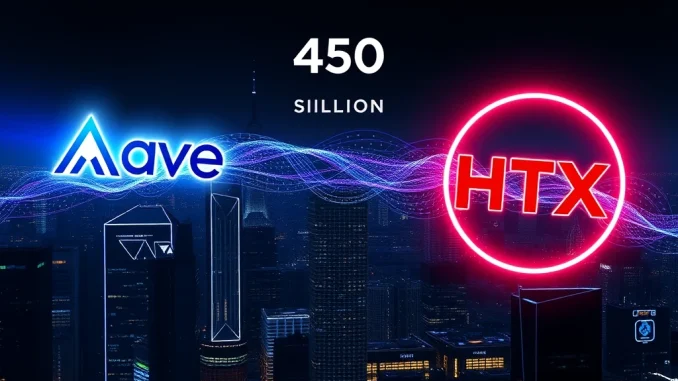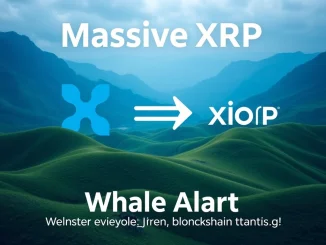
Hold onto your hats, crypto enthusiasts! A seismic event just rippled through the digital asset landscape. Whale Alert, the ever-watchful eye on blockchain transactions, has reported a colossal USDT transfer. A staggering 450,000,000 USDT, equivalent to approximately $450 million, has been moved from the decentralized lending platform Aave to the centralized cryptocurrency exchange HTX. This massive movement has sparked considerable buzz and speculation within the crypto community. Let’s dive deep into what this could signify and what it means for the market.
Massive USDT Transfer: Decoding the $450 Million Move
When Whale Alert sounds the alarm, the crypto world listens. The sheer scale of this USDT transfer is undeniably noteworthy. $450 million isn’t pocket change; it’s a sum that can significantly influence market dynamics. But what exactly happened? Here’s a breakdown:
- Source: The funds originated from Aave, a leading decentralized finance (DeFi) protocol known for its lending and borrowing services. Aave allows users to earn interest on deposits and borrow assets.
- Destination: The recipient is HTX (formerly Huobi), a prominent centralized cryptocurrency exchange facilitating the trading of various digital assets. HTX is known for its wide range of trading pairs and global user base.
- Asset: The transferred cryptocurrency is USDT (Tether), a stablecoin pegged to the value of the US dollar. Stablecoins are designed to minimize price volatility, making them popular for trading and hedging.
- Value: The transaction is valued at a whopping $450 million, underscoring the substantial amount of capital being moved.
This transaction raises several crucial questions. Why would such a large amount of USDT be moved from a DeFi platform to a centralized exchange? What are the potential implications for both Aave and HTX, and the broader crypto market? Let’s explore these aspects further.
Aave and HTX: Key Players in the Crypto World
To understand the significance of this crypto exchange transaction, it’s essential to recognize the roles of Aave and HTX within the cryptocurrency ecosystem.
Aave: The DeFi Lending Giant
Aave stands as a cornerstone of the DeFi movement. It empowers users to engage in decentralized lending and borrowing without intermediaries. Key features of Aave include:
- Decentralization: Aave operates on blockchain technology, removing the need for traditional financial institutions.
- Yield Generation: Users can deposit cryptocurrencies into Aave pools and earn interest.
- Borrowing: Users can borrow various cryptocurrencies by providing collateral.
- Innovation: Aave is known for its innovative features like flash loans and interest rate switching.
Aave’s popularity stems from its transparency, accessibility, and the attractive yields it offers to users seeking to earn passive income on their crypto holdings.
HTX: A Major Centralized Exchange
HTX, formerly known as Huobi, is a veteran in the cryptocurrency exchange arena. It provides a platform for users to buy, sell, and trade a wide array of cryptocurrencies. Key characteristics of HTX include:
- High Liquidity: HTX boasts significant trading volume, ensuring smooth and efficient trading.
- Diverse Trading Pairs: HTX offers a wide selection of cryptocurrency trading pairs, catering to diverse trader preferences.
- Advanced Trading Tools: HTX provides sophisticated trading tools and features for experienced traders.
- Global Reach: HTX serves a global user base, making it a major player in the international crypto market.
Centralized exchanges like HTX play a crucial role in providing on-ramps and off-ramps to the crypto market, facilitating trading and price discovery.
Crypto Whale Activity: Unpacking the Motives Behind Large Transfers
Transactions of this magnitude are often attributed to “crypto whales” – individuals or entities holding substantial amounts of cryptocurrency. Understanding crypto whale behavior is crucial to interpreting market movements. What could be driving this massive USDT transfer?
Here are some potential reasons:
- Profit Taking: The whale might have earned significant yield on USDT deposited in Aave and is now moving funds to HTX to realize profits by selling USDT for other assets or fiat currency.
- OTC Trading: Large transfers to exchanges can indicate over-the-counter (OTC) trading activity. Whales might use exchanges to facilitate large block trades privately, avoiding market slippage.
- Portfolio Rebalancing: The entity might be rebalancing its crypto portfolio, shifting funds from DeFi lending to exchange-based trading or investments.
- Preparation for Trading: Moving USDT to HTX could be a precursor to significant trading activity. The whale might be preparing to buy other cryptocurrencies on the exchange.
- Regulatory or Strategic Reasons: External factors like regulatory changes or strategic shifts in investment strategy could also prompt such large movements.
It’s important to note that without explicit confirmation from the entity behind the transfer, the exact motive remains speculative. However, analyzing on-chain data and market context can provide valuable insights.
Stablecoin Transfers: Implications for Market Stability
The fact that this transfer involves USDT, a prominent stablecoin transfer, adds another layer of complexity. Stablecoins are designed to maintain a stable value, typically pegged to fiat currencies like the US dollar. Large movements of stablecoins can have implications for market liquidity and stability.
Here’s how:
- Liquidity Injection: Moving a large amount of USDT to an exchange increases the available liquidity for trading. This can potentially facilitate smoother trading and reduce price volatility, at least in the short term.
- Demand Indicator: An influx of USDT to exchanges can sometimes signal increased demand for other cryptocurrencies. Traders might be positioning USDT to buy other assets.
- Market Sentiment: Large stablecoin movements can be interpreted as a gauge of market sentiment. Increased stablecoin holdings on exchanges could suggest traders are preparing for potential market dips or volatility.
- DeFi Ecosystem Impact: While moving USDT out of Aave might slightly reduce liquidity within the Aave protocol, the overall impact is likely to be minimal given Aave’s substantial total value locked (TVL).
The impact of this stablecoin transfer on market stability is nuanced and depends on the broader market context and the subsequent actions of the entity behind the transfer.
Why Exchanges Matter in Crypto Transactions
This event underscores the continued importance of crypto exchange platforms in the digital asset ecosystem, even with the rise of DeFi. Exchanges like HTX serve several critical functions:
- Fiat On-ramps and Off-ramps: Exchanges are essential for converting fiat currencies to cryptocurrencies and vice versa, bridging the gap between traditional finance and the crypto world.
- Trading and Price Discovery: Exchanges facilitate trading and price discovery for a vast range of cryptocurrencies. They provide the infrastructure for buyers and sellers to meet and execute trades.
- Liquidity Provision: Exchanges aggregate liquidity from numerous market participants, enabling efficient trading and reducing slippage.
- Custodial Services: Many users rely on exchanges to securely store their cryptocurrencies.
- Market Access: Exchanges provide access to the cryptocurrency market for a broad range of users, from retail investors to institutional players.
While DeFi platforms offer decentralized alternatives for lending, borrowing, and trading, centralized exchanges remain vital for market infrastructure and accessibility.
Actionable Insights and Future Outlook
What can we glean from this massive USDT transfer, and what should we watch for moving forward?
Actionable Insights:
- Monitor Whale Activity: Keep an eye on Whale Alert and similar services to track large transactions. These movements can offer clues about market trends and potential shifts in sentiment.
- Analyze Exchange Flows: Observe inflows and outflows of stablecoins to and from exchanges. Significant changes can indicate shifts in market liquidity and trader positioning.
- Stay Informed on DeFi and CeFi: Understand the interplay between DeFi platforms like Aave and centralized exchanges like HTX. Monitor developments in both sectors to grasp the evolving crypto landscape.
- Consider Market Context: Interpret large transactions within the broader market context. Factors like regulatory news, macroeconomic events, and overall market sentiment can influence the meaning of such transfers.
Future Outlook:
The crypto market remains dynamic and subject to rapid changes. Large transactions like this USDT transfer serve as reminders of the significant capital flows and evolving dynamics within the industry. As the market matures, we can expect continued interplay between DeFi and centralized finance, with large players strategically moving assets to capitalize on opportunities and manage risk.
In Conclusion: Decoding the Whale’s Move
The 450,000,000 USDT transfer from Aave to HTX is more than just a number; it’s a signal within the complex language of cryptocurrency transactions. While the exact motive remains shrouded in the anonymity of blockchain, our analysis reveals several plausible explanations, ranging from profit-taking to strategic portfolio rebalancing. This event underscores the crucial roles of both DeFi platforms like Aave and centralized exchanges like HTX in the crypto ecosystem. By monitoring whale activity, analyzing market flows, and staying informed, we can better navigate the ever-evolving world of digital assets and decipher the meaning behind these significant market movements. The crypto world never sleeps, and events like this keep us all on our toes, constantly learning and adapting in this exciting and revolutionary space.



